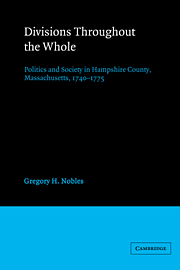Book contents
- Frontmatter
- Contents
- Preface
- Introduction
- 1 Family power and political relations in Hampshire County
- 2 The Hampshire County ministry and the Great Awakening: from revival to reaction
- 3 The revivalist removed
- 4 The legacy of religious dissent
- 5 New settlements in an unsettled society
- 6 The politics of parochialism
- 7 Revolution in the neighborhood
- Appendix
- Notes
- Bibliographical essay
- Index
3 - The revivalist removed
Published online by Cambridge University Press: 30 September 2009
- Frontmatter
- Contents
- Preface
- Introduction
- 1 Family power and political relations in Hampshire County
- 2 The Hampshire County ministry and the Great Awakening: from revival to reaction
- 3 The revivalist removed
- 4 The legacy of religious dissent
- 5 New settlements in an unsettled society
- 6 The politics of parochialism
- 7 Revolution in the neighborhood
- Appendix
- Notes
- Bibliographical essay
- Index
Summary
It eventually took a bitter dispute between a minister and his congregation for the Hampshire County ministers to demonstrate fully their growing concerns over the effects of revivalism and its attendant disorders. Ironically enough, in this case they came down against the minister. The celebrated dismissal of Jonathan Edwards from his Northampton church in 1750 not only supplied one of the most colorful and complex examples of ecclesiastical conflict in a single town; it also provided a means of realigning and reassessing local ministerial opinion in the post-Awakening years. The Edwards controversy was something no Hampshire County minister could ignore. When it was over Edwards was gone from the valley, banished to the remote Indian village of Stockbridge on the far western frontier. With him went the most vigorous mind and eloquent voice for evangelical religion in western Massachusetts. Remaining behind were the advocates of a more liberal theology and conservative sociology, most notably Robert Breck, who assumed a place of almost unchallenged leadership among the majority of ministers in the county.
There is hardly any need to go into great detail here about the complexities of Jonathan Edwards's controversy with the people of his own town. The story has been told repeatedly, and told very well. It may be accurate enough to say that by the mid-1740s the people of Northampton were growing disenchanted with their minister, and he with them. Edwards was by no means the easiest man to get along with.
- Type
- Chapter
- Information
- Divisions throughout the WholePolitics and Society in Hampshire County, Massachusetts, 1740–1775, pp. 59 - 74Publisher: Cambridge University PressPrint publication year: 1983



